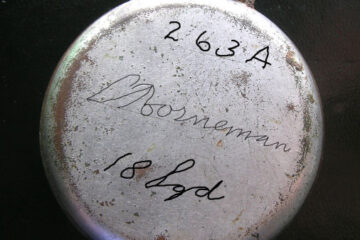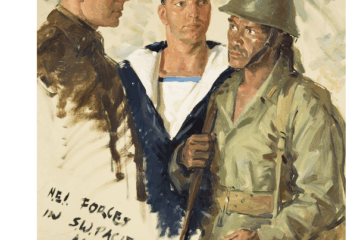After the fall of the Netherlands East Indies (NEI) in early 1942, Dutch military and intelligence efforts regrouped in Australia. From this base, the Netherlands Forces Intelligence Service (NEFIS) conducted reconnaissance, infiltration, and special operations in the South West Pacific Area (SWPA). Its field operations branch, NEFIS III, carried out some of the most daring missions of the war, often in coordination with Australian and American forces.
Formation of NEFIS III
NEFIS emerged from small Dutch naval and army intelligence teams that fled to Australia following the Japanese invasion. In 1943, the organisation was formalised with three sections:
- NEFIS I – intelligence collection and analysis
- NEFIS II – propaganda and psychological warfare
- NEFIS III – special operations and guerrilla support
NEFIS III was the field operations arm, responsible for inserting agents and small teams into occupied NEI to gather intelligence, establish local networks, and support guerrilla resistance. Its first operations were coordinated by Lieutenant‑Commander J. J. Quere, under the naval leadership of Captain‑Lieutenant‑at‑Sea G. B. Salm, and ultimately under the overall command of Lieutenant‑General Simon Hendrik Spoor.
Initially based in Melbourne, following the establishment of the Netherlands East Indies Government-in-Exile at Camp Columbia, Wacol, Brisbane in 1944 to be closer to MacArthur’s SWPA headquarters and the Allied Intelligence Bureau (AIB), with whom the Dutch closely cooperated.
in June-August 1944, the NEFIS was further expanded and three sections were added:
- (Section IV) Military Intelligence: (M.I.)
- (Section V) Civil affairs Intelligence
- (Section VI) Technical Photo Service (T.P.S.)
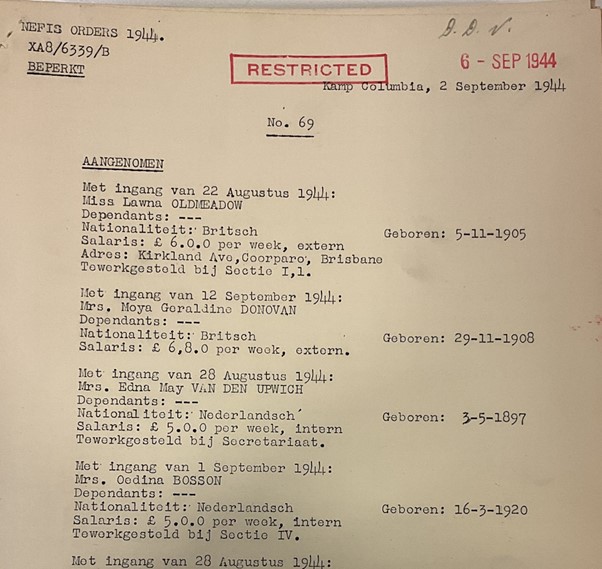


In the meantime, the NEFIS strength had grown to more than 300 men and women, not including navy and civilian personnel. Lieutenant-Colonel S.H. Spoor was now appointed as the new director of NEFIS. Section I was commanded by Major G.L. Reinderhoff, Section II under Lieutenant-at-Sea J.C. Smit, Section III under Lieutenant-at-Sea A.A. Fresco, Section IV under Lieutenant-Pilot-at-Sea J.H. Perié, Section V under Dr. G.W. Locher. Section VI was not yet operational. The organisation of the NEFIS was now prepared for the expected invasion of Java and the other territories of the NEI.

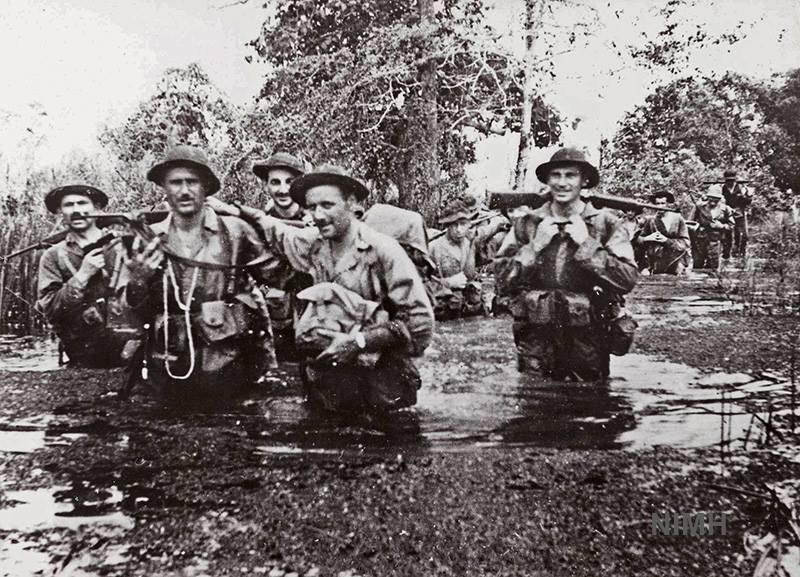
Types of NEFIS III operations
NEFIS III undertook some of the most hazardous intelligence missions of the Pacific War. Its work included:

- Reconnaissance and infiltration into occupied NEI islands such as Java, Sumatra, Borneo, and Timor, often by submarine or Catalina flying boat.
- Guerrilla support, linking with surviving KNIL (Royal Netherlands East Indies Army) detachments and Korps Insulinde to organise small‑scale resistance.
- Clandestine supply and liaison, bringing radios, weapons, and supplies to isolated operatives and local sympathisers.
- Coordination with Allied special forces, especially Z Special Unit and AIB’s Section B (Secret Intelligence Australia).
Many missions were conducted deep in enemy territory, where capture often meant torture or execution. Despite the risks, NEFIS III maintained a presence inside the occupied NEI throughout the war.
Key missions and examples
NEFIS III operations were typically small‑team insertions:
- Goldfish 1 (1944) – a successful insertion into Dutch New Guinea by Catalina to gather intelligence and establish local contacts.
- Timor and Borneo landings – teams coordinated with Z Special Unit and local allies to track Japanese troop movements and support guerrilla bands.
- Korps Insulinde deployments – this Dutch special unit, linked to NEFIS III, conducted 17 landings across Sumatra, Java, and Borneo, disrupting Japanese operations and relaying intelligence to Australia.
- Submarine support – Dutch submarines based in Fremantle inserted operatives, evacuated survivors, and conducted coastal reconnaissance.
These missions were high‑risk and often suffered losses. Many operatives were captured or killed, but the intelligence gathered informed Allied planning for raids, air strikes, and eventual liberation efforts.
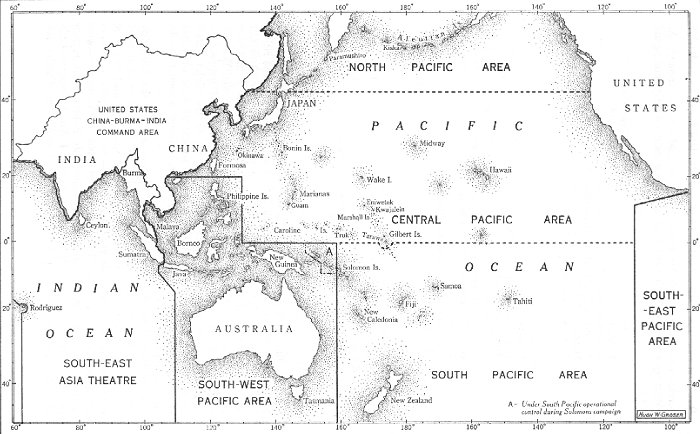
Allied cooperation and limitations
While NEFIS III demonstrated the Netherlands’ active participation in the Pacific War, its impact was constrained:
- MacArthur’s SWPA headquarters tightly controlled operations and prioritised American objectives.
- Dutch and Australian forces were often treated as secondary Allies, a source of frustration in The Hague and Batavia.
- Despite brave efforts, strategic impact was modest; missions were mostly localised, providing reconnaissance and symbolic resistance rather than large‑scale disruption.
Still, these operations kept the Dutch flag flying inside the NEI and strengthened Dutch‑Australian military cooperation. The intelligence and experience gained during NEFIS III missions also prepared the Dutch for their postwar re‑entry into the region.
Assessment
NEFIS III’s wartime contribution lay in courage, persistence, and symbolic presence. Its teams operated under extreme conditions and high casualty risk, providing valuable intelligence and maintaining Dutch visibility in the Allied war effort.
While the strategic effect on the Pacific War was limited, NEFIS III missions were a vital chapter in Dutch–Australian cooperation and remain a testament to the determination of a small exile force to keep fighting.
Some of the NEFIS operations
Most of these operations were combined operations mainly with Australian but some also with US personnel.
These maps and other reports on operations as shown below are from the following document: The Official History of the Operations and Administration of Special Operations – Australia (SOA), also known as the Inter-Allied Services Department (ISD) and Services Reconnaissance Department (SRD) Volume 2 – Operations – copy no 1 [for Director, Military Intelligence (DMI), Headquarters (HQ), Australian Military Forces (AMF), Melbourne]. Source National Library of Australia. I had to select those relevant pages from the document that were still readable.
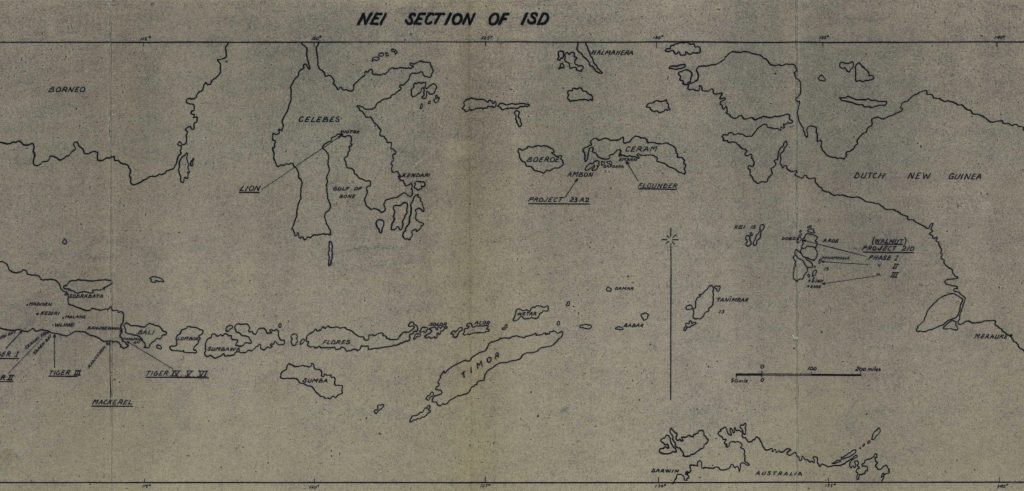
Korps Insulinde
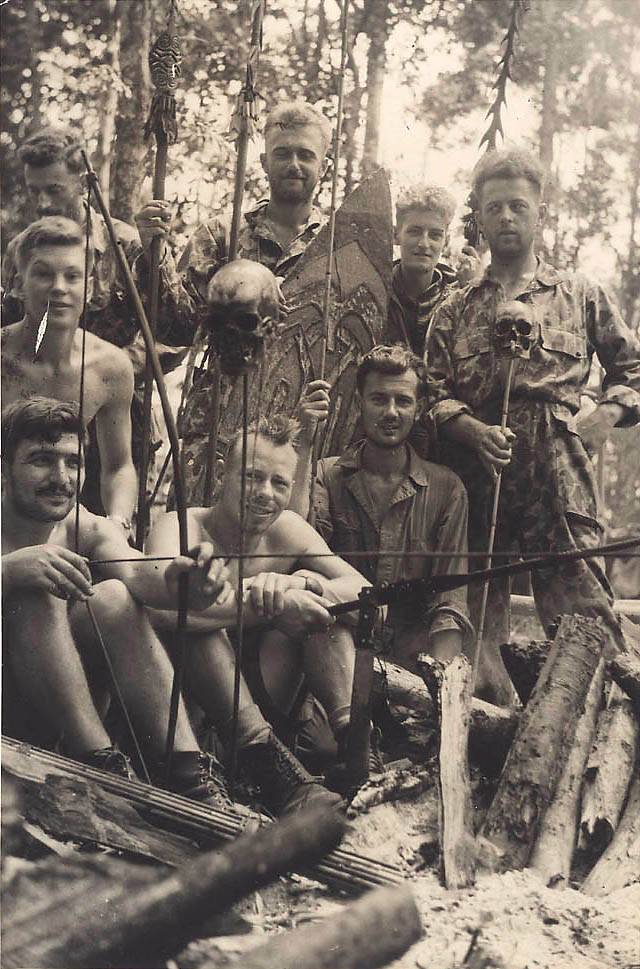
| NEFIS was eventually given its own clandestine operations unit, dubbed the Korps Insulinde. Drawn initially from 150 men of the 1st Battalion, Koninklijke Brigade “Prinses Irene,” which had trained in England in 1940-41 then had been shipped to the Pacific, arriving at Ceylon just after the fall of Java. They were stranded in Ceylon and grew increasingly frustrated of doing nothing. Finally on 1 August 1942 a special commando unit was established named Korps Insulinde, who underwent guerrilla training. From June 1943, 38 men of the Insulinde Corps concluded the training and were ready for commando actions in the NEI. They were added to NEFIS Section III. Also in 1944, Section I sent Major GL Reinderhoff to the staff of U.S. General Walter Krueger of the 6th U.S. Army, who had also landed on New Guinea in the meantime, to assist the Americans on the spot in planning future landings. These Free Dutch went commando quite literally, and served alongside the SOE’s Force 136 Intelligence in the region. Ultimately, No. 2 (Dutch) Troop of the No. 10 (Inter-Allied) Commando (also came out of the Koninklijke Brigade “Prinses Irene”) would contribute volunteers to the enterprise as well. In all, the Korps Insulinde would muster no less than 36 teams made up of 250 agents. They made 17 landings in Sumatra alone in 1943-44, in addition to operations in Borneo, the Celebes, New Guinea, and Java. |
Below is an overview of some of the more important operations of NEFIS III
NEFIS Van den Brandeler Patrol
Charles Gesner van der Voort and Dorone van den Brandeler shared a ‘mess’ in Shanghai, while working there for Dutch companies Holland-China Trading Company and Java-China-Japan Line. Dorone arrived in 1935, Charles in 1939. After the outbreak of WWII in The Netherlands, many young men abroad were called to arms. Charles had a brother serving in the army and was exempted, Dorone van den Brandeler went to England to join Princess Irene Brigade. In January 1942, he was sent to the Netherlands East Indies, with Insulinde Corps, together with his childhood friend Lou Bierens de Haan. Upon arrival in February 1942, the Netherlands East Indies were captured by the Japanese and the troops remained in Ceylon, current Sri Lanka. After training in Ceylon and British India, they were sent to Australia, where they served with NEFIS III, Netherlands East Indies Forces Intelligence Service. Under command of Dorone van den Brandeler, one of the missions was to the Digul river area in Dutch New Guinea, to investigate Japanese presence in the area. They were helped by local Dutch representatives and Papua population. (Source: Charles in Shanghai)

Operation Flounder
A NEFIS-III party Flounder was landed by a submarine on the south coast of Ceram on 31 December 1942, but the eight members (including Captain Nijgh and Sergeant J. Malawau) of the group were arrested by the Japanese the next day. They were taken by boat to Ambon and imprisoned at Fort Victoria. At least two where executed.
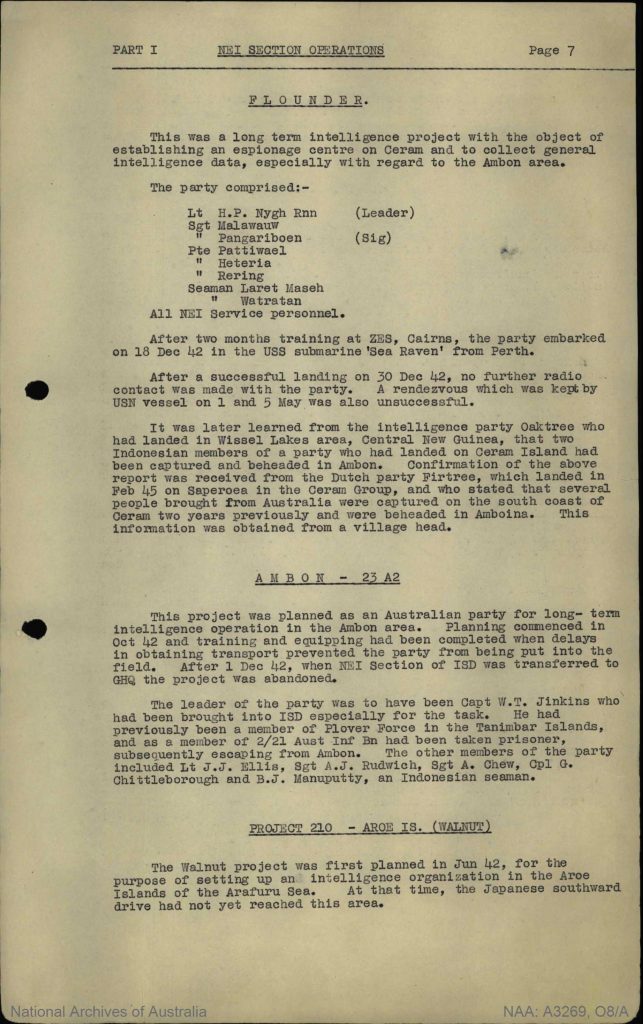
Operation Firetree

First Lieutenant Julius Tahija led the NEFIS-III party Firetree in February 1945. This party consisted of ten men and was intended to obtain general and military information about Ambon and surroundings, to make observations about Japanese ship and aircraft traffic and to draw up weather reports. The group departed from Australia by the Dutch submarine K XV and set sail for Mangoli. Tahya disembarked here with five others but decided to return to Ambon due to a lack of good landing places for unloading goods. On September 12, he landed with his men on the east coast of Saparoea and then decided to return to Australia; all in all, this mission provided valuable information.
Operation Whiting
Party Whiting was an espionage operation in 1943 in which Sergeant Thijs Staverman and Sergeant Leonard Siffleet from Gunnedah were sent to New Guinea together with the Ambonese corporals M. Raharing and H. Pattiwael. The group split up into two parties codenamed “Whiting” and “Locust”. Whiting Party set out for the Hollandia area, while Locust Party continued to operate in the area south and southeast of Aitape. Those involved did not survive the operation, three were beheaded.

Operation Tiger
Operation Tiger was divided in sic teams (I-VI) they all operated on the island of Java between November 1942- July 1943. Ten 10 men landed in six different teams. It is thought all members were captured and shot as none were seen again.
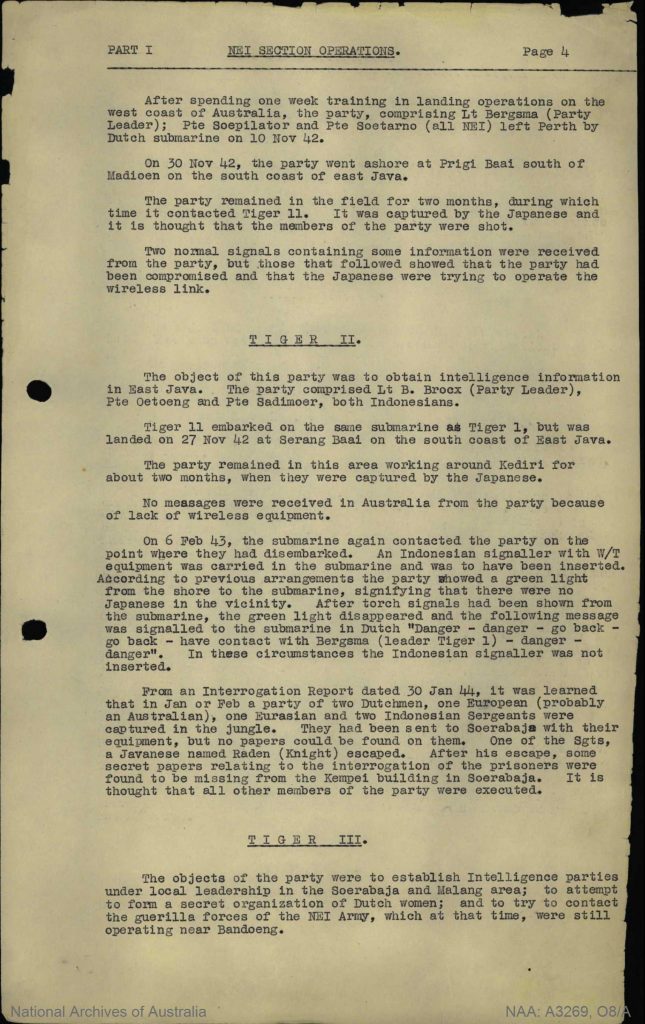
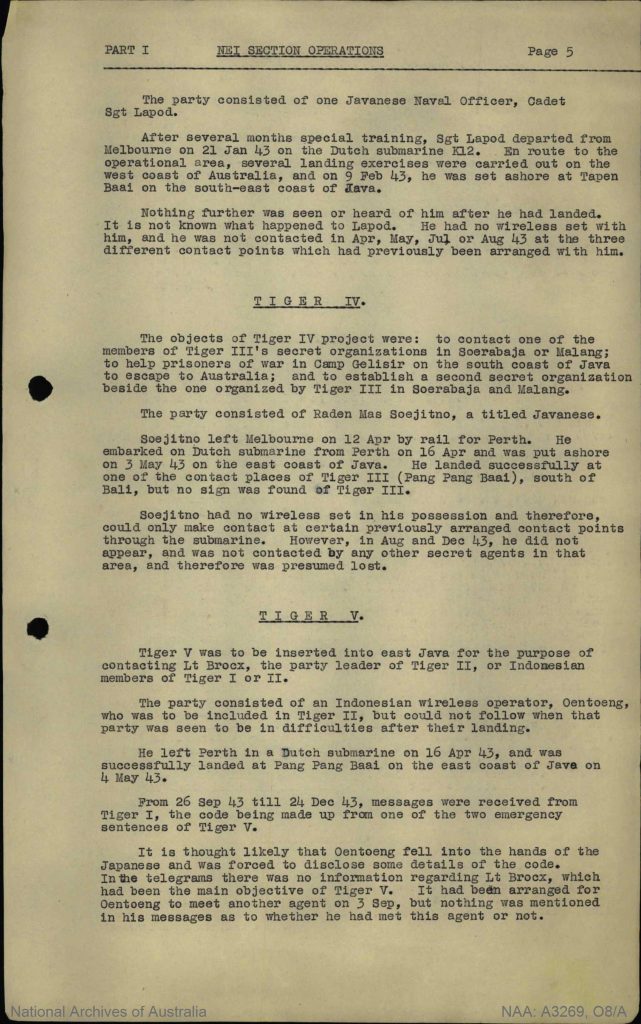

Operation Mackerel
According to “The Official History of the Operations and Administration of Special Operations – Australia [(SOA), also known as the Inter-Allied Services Department (ISD) and Services Reconnaissance Department (SRD)] ; Operation Mackerel was an operation carried out in World War Two by the Australian Imperial Force. Three men went ashore on Java in September 1942 to collect information. They were accompanied by two members of the Dutch sub K12. but the mission had to be abandoned early (Volume 2 – Part 1 page 3”]. p. 26).

Operation Walnut
Operation Walnut took place in three phases on the Aroe Islands:
Walnut I – a party of two landed in July 1942 and returned in September.
Walnut II – party of two landed in February 1943 and captured August, presumed killed.
Walnut III – On 12 July 1943 a reconnaissance patrol consisting of ten, WALNUT III was inserted on Djieo, a small island north of Enoe Island, using Hoehn military foldboats. Their fate is unknown, presumed killed.
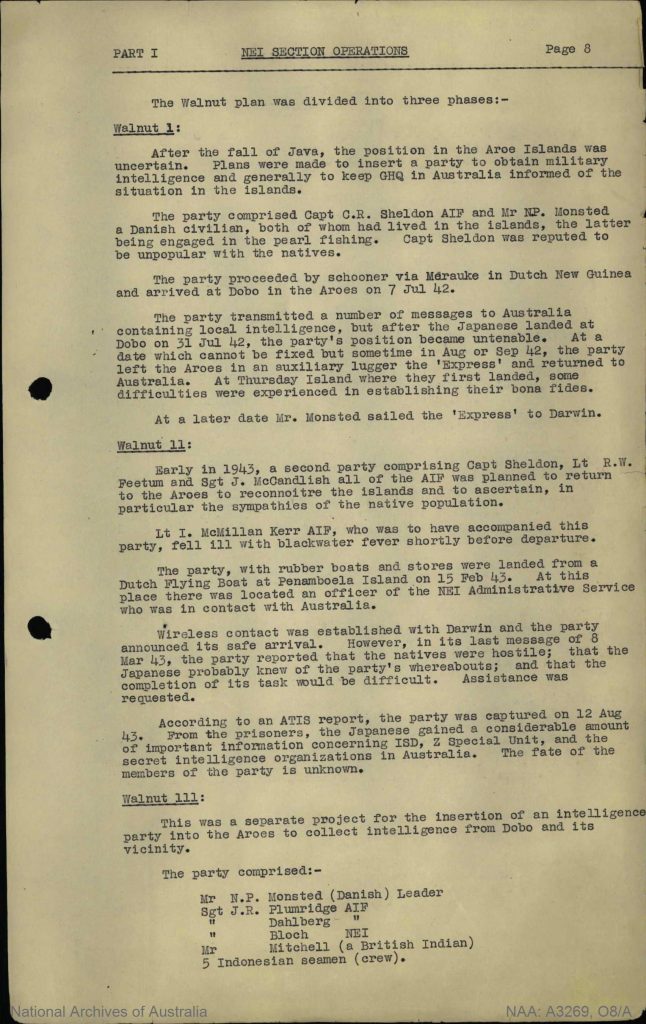
Operation Oaktree
Operation Oaktree took place in Dutch New Guinea. Under the command of Captain Jean Victor de Bruijn, some 40 Dutch and Australian soldiers operated in the highland region of Western New Guinea for more than two years between December 1942 and July 1944.

Book: Acties in de Archipel J.J. Nortier (in Dutch)
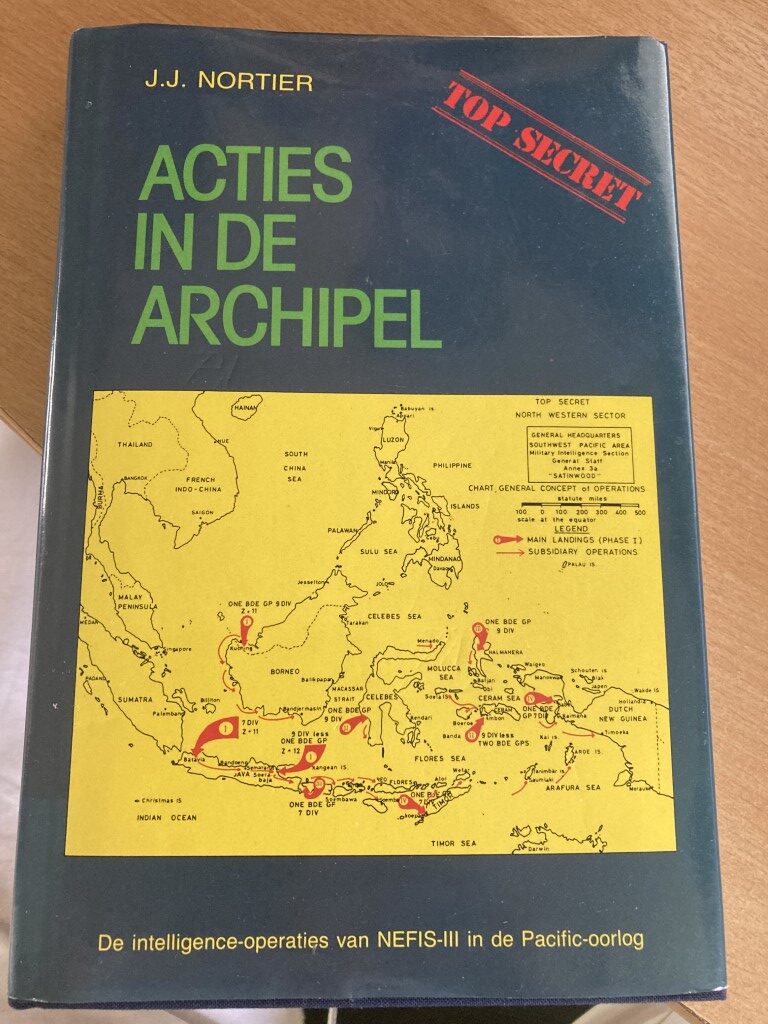
De intelligence-operaties van NEFIS-III in de Pacific oorlog
Gaat over de activiteiten van de derde sectie van de Netherlands Forces Intelligence Service (NEFIS III) beschreven: de totale inzet van de ingebrachte agenten voor de zaak van de vrijheid, in acties die vaak bij voorbaat al hopeloos leken.
‘De boot nam op het strand een groen licht waar, hetgeen volgens afspraak aangaf dat alles veilig was en zich in de omgeving geen vijand bevond. De K XII reageerde met één lichtflits. Kort daarop werd met een lamp en in het Nederlands geseind: ‘gevaar–gevaar, ga terug–ga terug–heb contact (???) Bergsma, gevaar–gevaar.’ Tussen de woorden ‘contact’ en ‘Bergsma’ volgde een woord van een paar letters dat niet opgenomen kon worden. Brunsting gaf een witte lichtflits, waarop na ongeveer 15 minuten van het strand opnieuw de woorden ‘gevaar–gevaar’ kwamen, gevolgd door een vraagteken en ‘OK’. De K XII antwoordde met de letter R maar er kwamen geen seinen meer van de wal. De hele zaak bleef een raadsel.’
Het viel niet mee, na de overrompeling van Nederlands-Indië door Japan in 1942, om in korte tijd een organisatie op te zetten die in het bezette gebied spionageactiviteiten kon gaan ontwikkelen. De Nederlanders en Indonesiërs die daar eendrachtig aan begonnen stonden met volstrekt lege handen. Geen wonder dat de verwarring soms groot was en dat men keer op keer faalde. In ACTIES IN DE ARCHIPEL worden de activiteiten van de derde sectie van de Netherlands Forces Intelligence Service (NEFIS III) beschreven: de totale inzet van de ingebrachte agenten voor de zaak van de vrijheid, in acties die vaak bij voorbaat al hopeloos leken. De successen die ondanks alle tegenslag toch geboekt werden verdienen des te meer ons respect.
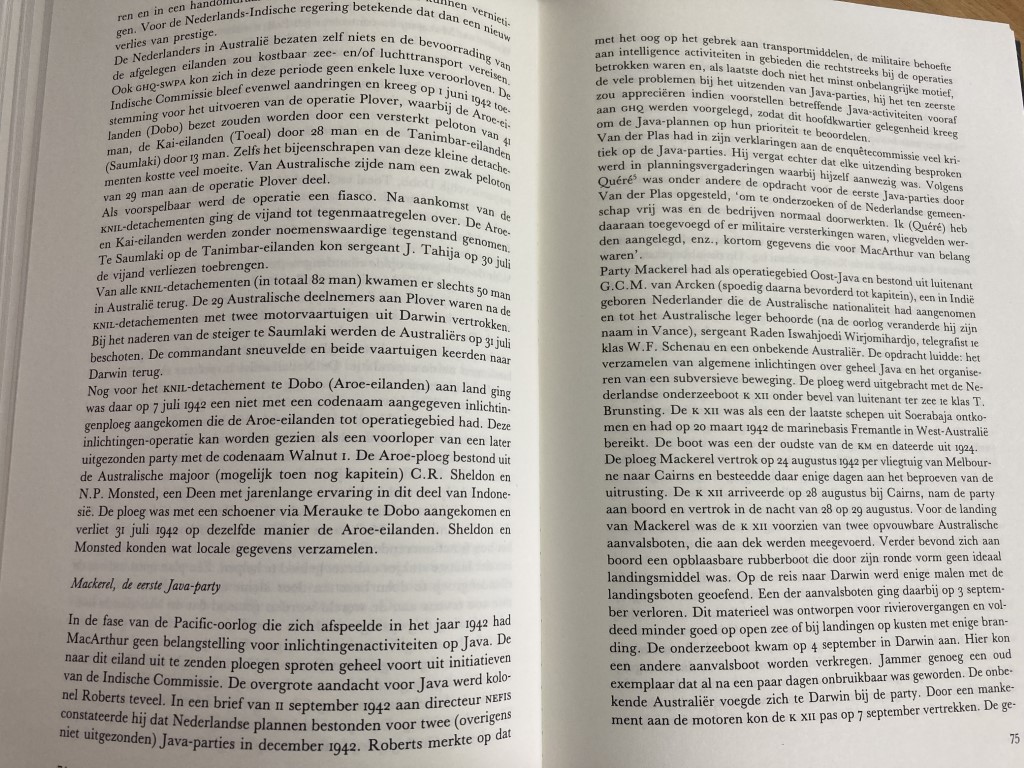

Notable members
- Charles Bartelings (in Dutch)
- Rudy Albert Blatt, assistant to Simon Spoor (in Dutch)
- Wim van Bolten, head of the NEFIS
- Hendrik Johan de Haas, executed by the Kempeitai (Japanese Military Police) in 1945
- Leon Jungschläger (in Dutch)
- Cornelis Nagtegaal (in Dutch)
- Gerard Leonard Reinderhoff (in Dutch)
- Pete Reimer (in Dutch)
- Julius Tahija, leader of a NEFIS-III party
- Abraham de Jong (in Dutch)
- Simon Spoor, director of NEFIS
- Mans Dijkema, third wife of Simon Spoor. She was a member of the KNIL Women’s Corps, whom Spoor had met in 1942 at NEFIS, she independently acted in several military functions.
- Dominggus Wattimury, Sergeant 1st Class, member NEFIS III, participated in Firetree Party. He is also mentioned in the pdf below.
- Wilhelmus Marius van der Veur, lieutenant, member NEFIS III, in charge of supply and in charge of setting up a camp in Merauke.
- Captain Max Horstink– Topographic services
- Jean van Schilfgaarde – secretary at NEFIS Camp Columbia, Brisbane
- Joan McConachy – secretary (possibly at NEFIS)
Article written by Paul Budde based on sources from Australian War Memorial, Wikipedia and the NIOD Institute for War, Holocaust and Genocide Studies in the Netherlands
See also:
The Battle of Timor – 1942-1943
Sparrow Force – Allied guerrilla force in Timor WWII
The Free Dutch vs the Emperor in the East Indies
‘Zakheus Pakage and His Communities’ (interesting details of the Oaktree Party pages 56-82)
